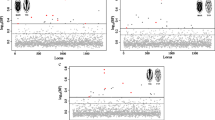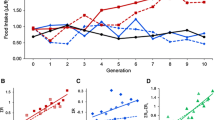Abstract
The handedness of gastropods is genetically determined. The freshwater gastropod Lymnaea stagnalis is a normally dextral species, but contains minor sinistral populations. The gene responsible for handedness determination in this species is predicted to function maternally and specifically in the dextral-ovipositing snail. In this study, we used differential screening and cDNA subtraction to isolate eight “dextral genes” that are specific to, or enriched in, the dextral-ovipositing strains of L. stagnalis. These genes were promising candidates for the handedness-determining gene. In order to determine whether the true handedness-determining gene was among them, we tested for genetic correlations between the level of expression of each dextral gene and the handedness phenotype, i.e., the chirality of the next generation offspring, by using a collection of backcross F2 progeny of F1 offspring from crosses between dextral and sinistral strains. Although the present study could not identify the handedness-determining molecules, this approach appears to be promising for the isolation of such developmentally important genes.




Similar content being viewed by others
References
Asami T (1993) Genetic variation and evolution of coiling chirality in snails. Forma 8:263–276
Bottke W, Burschyk M, Vollmer J (1988) On the origin of the yolk protein ferritin in snails. Roux’s Arch Dev Biol 197:377–382
Crampton HE (1894) Reversal of cleavage in a sinistral gastropod. Ann NY Acad Sci 8:167–170
Freeman G (1983) The role of egg organization in the generation of cleavage patterns. In: Jeffery WR, Raff RA (eds) Time, space, and pattern in embryonic development. Wiley-Liss, New York, pp 171–196
Freeman G, Lundelius JW (1982) The developmental genetics of dextrality and sinistrality in the gastropod Lymnaea peregra. Wilhelm Roux Arch Entwicklungsmech Org 191:69–83
Hosoiri Y, Harada Y, Kuroda R (2003) Construction of a backcross progeny collection of dextral and sinistral individuals of a freshwater gastropod, Lymnaea stagnalis. Dev Genes Evol 213:193–198
Meshcheryakov VN, Beloussov LV (1975) Asymmetrical rotations of blastomeres in early cleavage of gastropoda. Wilhelm Roux Arch Entwicklungsmech Org 177:193–203
Satou Y, Kusakabe T, Araki I, Satoh N (1995) Timing of initiation of muscle-specific gene expression in the ascidian embryo precedes that of developmental fate restriction in lineage cells. Dev Growth Differ 37:319–327
Sturtevant AH (1923) Inheritance of direction of coiling in Limnaea. Science 58:269–270
Supp DM, Witte DP, Potter SS, Brueckner M (1997) Mutation of an axonemal dynein affects left-right asymmetry in inversus viscerum mice. Nature 389:963–966
Thitamadee S, Tuchihara K, Hashimoto T (2002) Microtubule basis for left-handed helical growth in Arabidopsis. Nature 417:193–196
Xu B, Janson JC, Sellos D (2001) Cloning and sequencing of a molluscan endo-β-1,4-glucanase gene from the blue mussel, Mytilus edulis. Eur J Biochem 268:3718–3727
Acknowledgements
We are grateful to Prof. Gary Freeman and Judith W. Lundelius (University of Texas) for their advice on the construction and maintenance of the laboratory snail stocks, and to Prof. Takahiro Asami (Shinshu University) for his kind assistance in obtaining the snails. We thank Dr. Miho Shimizu in our laboratory for her help with construction of the libraries. We also wish to thank other past and present members of our laboratory, especially Midori Kodama, Yuki Kadoishi, Keita Miyoshi, and Kota Yoshimatsu, for their efforts in maintaining the snail stocks. The sequences reported in this paper will appear in the DDBJ database with the respective accession numbers (DSC-1: AB159144, DSC-2: AB159145, DIC-1: AB159146, DIC-2: AB159147, DIC-3: AB159148, DEC-1: AB159149, DEC-2: AB159150, DEC-3: AB159151, RIC-1: AB159152, and YGSC-1: AB159153).
Author information
Authors and Affiliations
Corresponding author
Additional information
Edited by N. Satoh
Rights and permissions
About this article
Cite this article
Harada, Y., Hosoiri, Y. & Kuroda, R. Isolation and evaluation of dextral-specific and dextral-enriched cDNA clones as candidates for the handedness-determining gene in a freshwater gastropod, Lymnaea stagnalis . Dev Genes Evol 214, 159–169 (2004). https://doi.org/10.1007/s00427-004-0392-6
Received:
Accepted:
Published:
Issue Date:
DOI: https://doi.org/10.1007/s00427-004-0392-6




